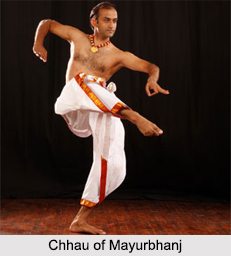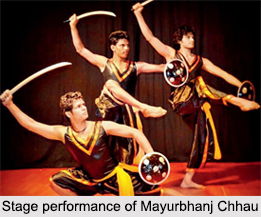 Chhau Dance is glorious heritage of Mayurbhanj district. The kings of Mayurbhanj like Maharaja Shriram Chandra Bhanjdeo and Pratap Chandra Bhanjdeo composed the famous "War-Dance". Elements of folk, martial, traditional, classical art have been woven into the Mayurbhanj chhau. The other essential elements of Chhau dance is motivated by the themes of Indian epics like Mahabharata and Ramayana, as well as tribal and folk elements which are woven into this dance form. `Dhumsa`, `Chad Chadi`, `Dhol` and `Mohuri` comprise the orchestra which is played during the performance of Chhau dance. Vocal music accompanies the dance performance.
Chhau Dance is glorious heritage of Mayurbhanj district. The kings of Mayurbhanj like Maharaja Shriram Chandra Bhanjdeo and Pratap Chandra Bhanjdeo composed the famous "War-Dance". Elements of folk, martial, traditional, classical art have been woven into the Mayurbhanj chhau. The other essential elements of Chhau dance is motivated by the themes of Indian epics like Mahabharata and Ramayana, as well as tribal and folk elements which are woven into this dance form. `Dhumsa`, `Chad Chadi`, `Dhol` and `Mohuri` comprise the orchestra which is played during the performance of Chhau dance. Vocal music accompanies the dance performance.
Origin of Chhau Dance
The origin of the term `Chhau` is shrouded in mystery, though some people are of the view that Chhau is a derivation of the word `Chhaya` or shadow. Colourful masks are employed by the Chhau dancers of Mayurbhanj District during their dance performances and these masks are referred to as `Chhau`.
Chhau dance might also have received its name from the Chhau mask. Some Chhau exponents and specialists claim that Chhau dance obtained its name from `Chhaushree`. There exists yet another belief which states that Chhau has received its present name from the term `Chhauni`, which was the name of the camp during the time of military operation. The regional inhabitants of Mayurbhanj District feel that Chhau dance was displayed for the purpose of entertaining the Odiya warriors of the camp.
Performance of Mayurbhanj Chhau
The Mayurbhanj Chhau is performed in several ways; Group, duet and Solo. The subject matter of Chhau is substantially and thematically brought from folklores of the Mahabharata, Ramayana, Puranas and cults of Krishna. The beginning probably started without any such theme but gradually it started to develop one. As per the typical traditions of Mayurbhanj district, the "Paika Akhada" or Village gymnasiums exists in every part of the dance. The local youths generally assemble every day in the evening for their traditional exercises and meanwhile dance with swords as well accompanied by the music coming from drums. Various movements and poses of the dance form holds the delicate art of Chhau building physical excitement in bodies of the fighters which leads to increase in high spirit for the battle.
Festivals of Mayurbhanj Chhau
All regions in Myurbhanj feature Chhau and hold their cultural heritage. During festivals like Dusshera, Chhau is performed with grandeur. The occasion is hosted by organising stage shows where acrobatics, gymnastics and Chhau is performed by different troupes. The participants win prizes too as the competition takes place in every district. Another popular festival where it is performed is "Chaitra Parva" or festival of spring. The dance performance is held non-stop for thirteen consistent days where the entire community participates. As it is performed with such extravangza, different families of traditional artists gather during nights at open spaces to witness the proceedings.
Features of Mayurbhanj Chhau
Six 'Topka' or 'Chalis' and 36'uflis' make up the Chhau of Mayurbhanj District. The unique characteristic of Mayurbhanj Chhau is its involvement of as many as 200 dance item numbers, unlike any other regional dances of this Indian district or even any other dance form practised in portions of the world. 'Jamdeb', 'Mahadev', `Nataraj`, `Dandi` and `Sabar Toka` are only a few of the numerable solo items which are a part of this splendid dance. The well-known group items of Mayurbhanj Chhau include 'Kailash Leela', 'Kirat Arjun', 'Dhajatal', 'Bainshi Chori', 'Kelakeluni', 'Tamudia Krishna' and 'Mayasabari'. Lord Bhairab is the presiding deity of the Chhau dance of Mayurbhanj District. Currently, the Mayurbhanj Chhau has won international fame and utilizes the element of visual poetry. Lyrical and dynamic style is the inherent theme of this kind of dance.
 Music of Mayurbhanj Chhau
Music of Mayurbhanj Chhau
The Chhau of Mayujbhanj contains both classical Ragini and Raga along with definite Laya and Tal. Extensive uses of Tals like Ektal, Kharba, Trital, Rupak, Dadra, etc are found. Classical dance numbers like Kirat Arjuna, Kailash Leela, etc. are based on usage of classical instruments like Chadachadi, Dhumsa, Dhol, Madhuri which are mainly used for Chhau. The final stage of music is of Jhumar, a folk music. The vocals of songs are written in folk lyrics too.
Techniques of Mayurbhanj Chhau
Apparently, the techniques for this dance are dependent similarly on the techniques of tandava. Gradually during the development, other lakshana or rasas became inevitable. However, the reformers of the dance form formed three kinds of lakshana. They are:
•Hathiyar Dhara: The word "Hatiyar" means weapon and "Dhara" means to hold. The performance goes like the performer hitting the opponent which is called a Tandava stance.
•Kalibhanga: The word "Kali" means bud and "Bhanga" means to break. This is Lasya dance where the stance is a softer one when picture of a soft green plant and stem of bud is created.
•Kalikata: This shows cutting of a stem and cutting the bud off using a weapon. Both of the popular units used here are known as Chauk, Chali, Dharan and Ulfi.
Costume of Mayurbhanj Chhau
The Mayurbhanj Chhau has developed physical vigour in the movements of the dance. Masks impose limitations to freedom of physical movements but they add beauty and grace. In Mayurbhanj it is the movement alone on which the dance has been based and no masks are used by the dancers.



















